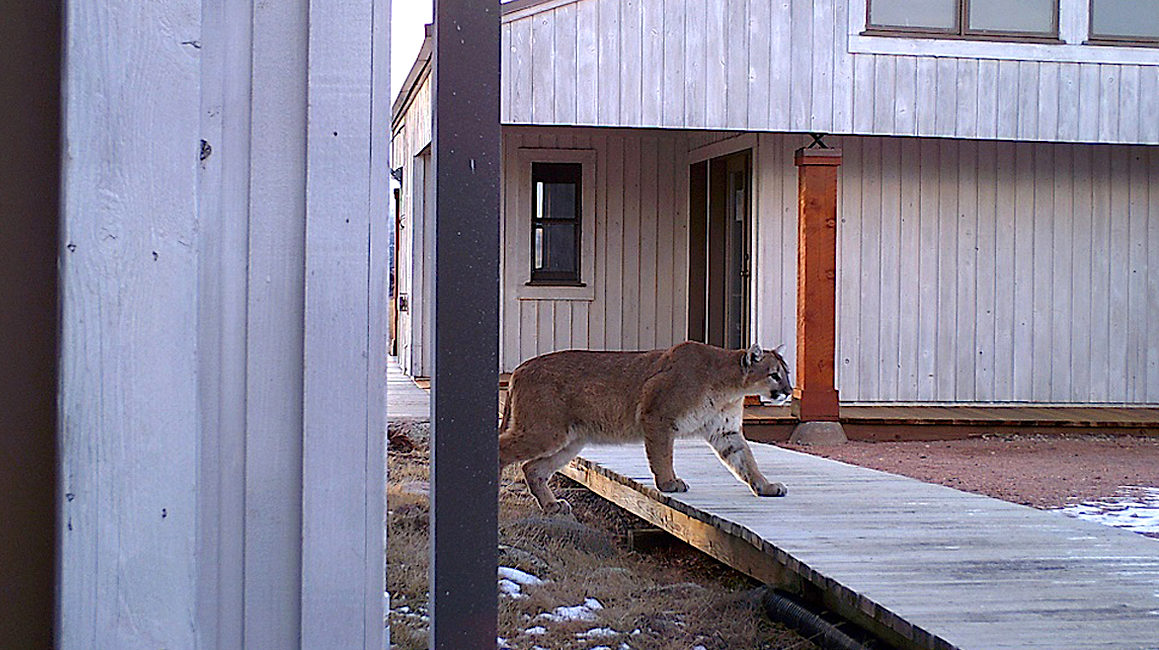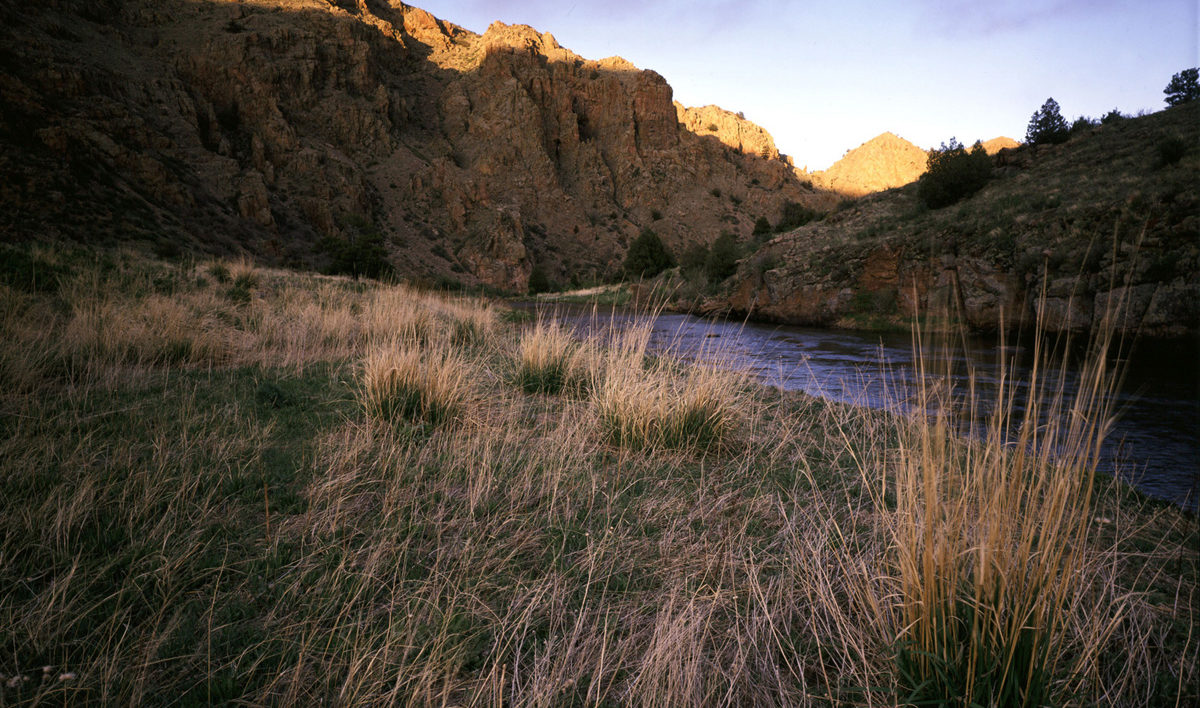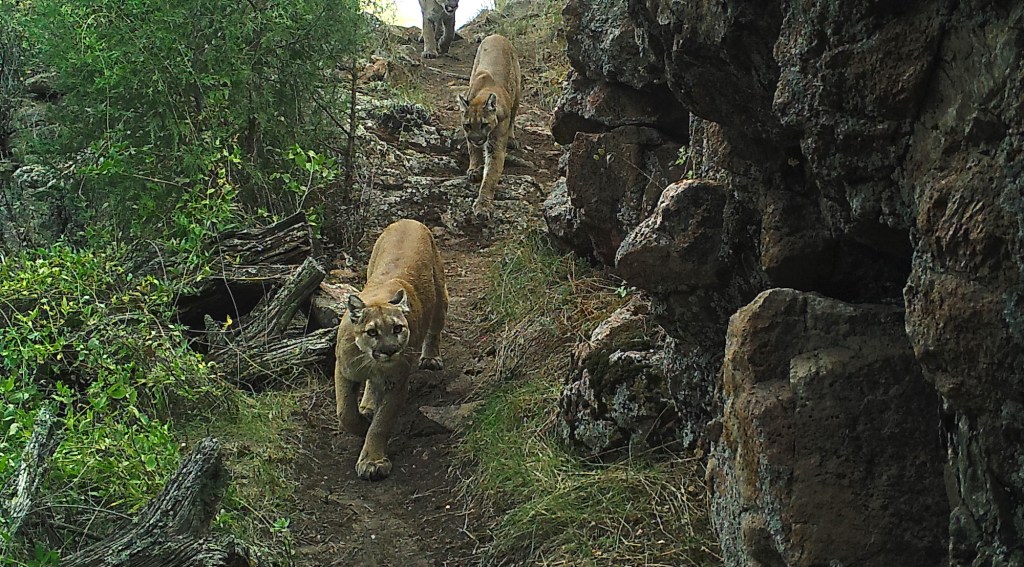For more than 30 years, The Nature Conservancy’s Phantom Canyon Preserve has sought balance between the needs of people and the needs of wildlife.
The 1,200-acre preserve is situated in one of the last roadless canyons on Colorado’s Front Range, where herds of bighorn sheep and elk roam. It is home to more than 200 plant species, including some that are rare and endemic.
But the preserve sits only 30 miles from the growing city of Fort Collins. It is connected to a landscape dotted with private ranches. On its way to fields and cities the North Fork of the Cache la Poudre River provides habitat for native fish like the colorful Iowa darter, and for the American dipper, a bird that forages underwater.
Downstream, the river is utilized for irrigation and utilities. Its water is essential for everything from hay for livestock to the region’s famous breweries.
A recent trail camera photo taken at Phantom Canyon Preserve perhaps serves as the perfect illustration of the blurry line between the human and the natural. It captures a mountain lion striding, not through wilderness, but through the preserve’s cluster of buildings.

“The preserve is not open for six months of the year,” says Sally Ross, The Nature Conservancy in Colorado’s Laramie Hills program director. “I visit a couple times a month and collect the cards from the trail camera. Usually I just sort through lots of rabbit photos. But this time, there was this big female lion, walking right in front of the bunkhouse.”
Despite the surprise of that particular mountain lion, Phantom Canyon is cat country. About 18 months ago, Ross began noting more scat and tracks on her visit to the preserve. In the mid-2000’s, the Colorado Department of Fish and Wildlife culled mule deer due to the presence of Chronic Wasting Disease. The deer herd has since increased, and with it came signs of mountain lions.
Not long after Ross began noticing scats, a trail camera captured this footage of a mountain lion with cubs.
Trail cameras at the preserve have captured images of other interesting wildlife, including black bears, bobcats, elk and mule deer.
While Ross acknowledged this is anecdotal, she has noticed one change around preserve headquarters with the increase in mountain lion sign and sightings. “When I started here three years ago, the rabbits would chew the wires on cars we parked around the preserve. It cost TNC a lot of money,” she says. “Since the increase in lion signs, we haven’t had any issue with rabbit damage.”

More About Phantom Canyon Preserve
The Nature Conservancy acquired the 1,200-acre Phantom Canyon Preserve in 1987, primarily to protect native plants. Since then, it has become an anchor to build community engagement and to protect private lands on the Colorado Front Range.
The Conservancy has worked with utilities, land management agencies, private landowners and other conservation groups to create a 22-mile corridor that connects high elevation public lands in the west (Rocky Mountain National Park) to low-elevation private ranches in the east.
Since the effort began, there have been approximately 100,000 private acres protected under some form of conservation management, which is connected to 110,000-acres of publicly protected lands.
Today, Phantom is used as a place to inspire, educate, and demonstrate to our users the impact of conservation and good land management practices. Read more about the project.




So the rabbits aren’t chewing on the car wires any more…………because the mountain lions have eaten the rabbits?? Or scared them away??
very interesting to learn of this partnership. Great to provide a corridor for the animals between areas.
Wonderful News….thank you.
This is exactly as it should be. It gladens my heart – both for the wildlife as well as for American humanity.
I love the shots of the beautiful mountain lions thank you for your dedication and knowledge.
How much i loved this piece, with trail camera pictures…gorgeous mountain lions in their natural setting, with the camera resolution perfect!! i really appreciate the work you do, as well as your presentation to us out here. i am in syracuse ny…close to the Adirondacks, which we love. we are always having active discussions about who thinks he saw a mountain lion…and we have ongoing discussions about whether wolves could be reintroduced. we do however have a complement of moose…quite exciting here.
Pretty cool. I’ve only seen two mountain lions in the wild here in Arizona and it was exciting to say the least.
To read of your efforts gives me a little hope.
I have been blessed to see 2 Lions. One in the San Gabriel Mtn’s of southern California, as I hiked the 4 mile trail into my wilderness cabin. More recently, I followed one up a mountain road to my home in northern Arizona! For more than a long city block, it lopped up the road before me. Watching it from 30 feet, I could see its amazing musculature in motion, its massive muscles rippling beneath its taught shiny coat. I will take that memory to my deathbed.
Loved seeing this. Thank you.?
Providing and preservation of natural habitat for such beautiful creatures like these Mountain Lions is a very noble cause. Thanks for great organizations like the Nature Conservancy that provide hope for so many threatened species and by making room for our animal friends contribute to our own survival.
Beautiful! Nature….left alone, manages fine without us .
Beautiful animals. Thank you for your tireless efforts for their conservation and that of other animals.
What an inspirational article! It is nice to hear some positive news on wildlife for a change! Keep up the good work!
Really COOl to see the mountain lions and the fact that this acreage is connected so that there is a corridor to various elevations. Wildlife needs this to happen in multiple areas to help ensure their safety and proliferation of the species.
Providing corridors that provide interaction between different populations of a species provides greater genetic diversity and reduces the harm of inbreeding found in isolated populations.